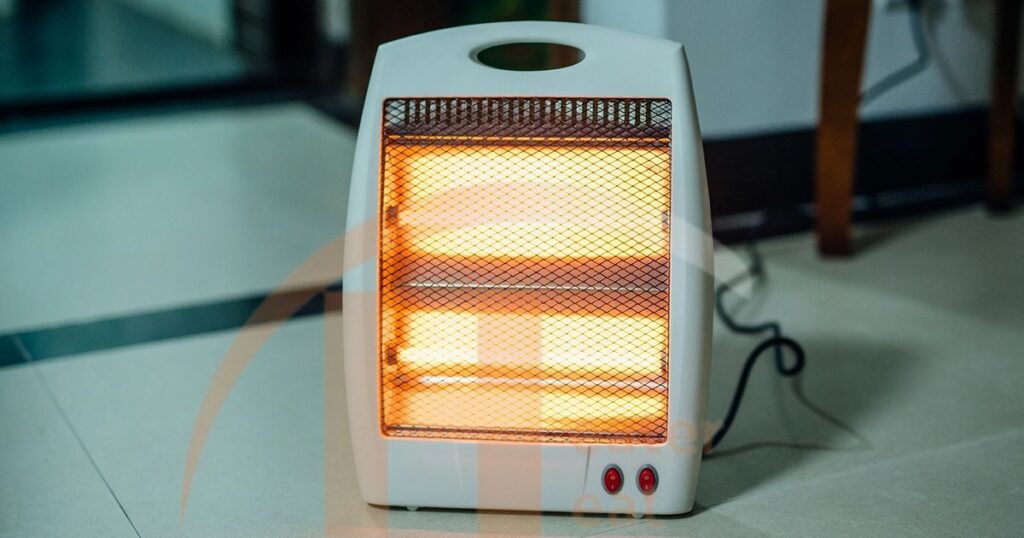An Electric Fireplace mimics the ambiance of a traditional fireplace but is an electrically powered heating device. On the other hand, a space heater is a compact device designed to provide focused warmth in specific areas.
Imagine cozy winter evenings, and you’re faced with a choice: the allure of an electric fireplace, radiating warmth with its simulated flames, or the practical efficiency of a space heater, compact and portable. Choosing between them involves understanding their nuances, and we’re here to guide you through the warmth of both options.
While electric fireplaces add a touch of sophistication to your living space, space heaters offer flexibility, easily warming up chilly corners. This exploration delves into how these heating options work, their pros and cons, safety considerations, and the crucial distinctions that help you make an informed decision for your home.
Electric Fireplaces

Fireplaces stand at the intersection of functionality and aesthetics, offering warmth while creating a captivating ambiance in any living space.
How do Electric Fireplaces Work?
Understanding the enchanting mechanism behind Fireplaces unveils a simple yet effective process. These fireplaces use electricity to power LED lights and, in some cases, rotating mirrors to create the illusion of flickering flames. The heat is generated through a fan and dispersed into the room, giving you the cozy feel of a traditional fireplace without needing wood or gas.
Types of Electric Fireplaces

Fireplaces come in various styles, catering to different preferences and interior designs
- Wall-Mounted Electric Fireplaces: Sleek and modern, these save floor space.
- Freestanding Stoves: Resemble traditional wood stoves, adding a rustic touch.
- Fireplace Inserts: Retrofit into existing traditional fireplaces for a modern upgrade.
- TV Stand Fireplaces: Combine entertainment and warmth for a multifunctional unit.
Uses of Electric Fireplaces
These fireplaces serve not only as heating sources but also as focal points in home décor
- Create a cozy and inviting atmosphere.
- Efficiently warm specific areas in your home.
- Flames can be enjoyed without the heat during warmer seasons.
Pros and Cons of Electric Fireplaces
Considering the merits and drawbacks of Fireplaces aids in informed decision-making
- Pros
- Adjustable flame settings and heat levels for personalized comfort.
- There is no need for chimneys or venting, making installation hassle-free.
- Most electric fireplaces are energy-efficient, reducing overall heating costs.
- Cons
- Effective for small to medium-sized spaces.
- Higher upfront costs compared to some traditional heating options.
- While impressive, the flame simulation may not match a real fireplace.
Safety Tips for Electric Fireplaces
Prioritizing safety is crucial when enjoying the warmth of Fireplaces
- Check cords and plugs for any signs of wear or damage.
- Adhere to the recommended usage guidelines provided by the manufacturer.
- Maintain a safe distance between the fireplace and any combustible materials.
- Avoid leaving the fireplace unattended, especially when children or pets are around.
Space Heaters

When the chill sets in, space heaters step up as versatile solutions, providing targeted warmth exactly where it’s needed. Compact and efficient, these devices have become indispensable in many households.
How do Space Heaters Work?
Space heaters operate on the principle of converting electrical energy into heat. Most commonly, they utilize a heating element, such as a metal coil or ceramic plate, to generate warmth. A fan then distributes this warmth into the surrounding area. Some advanced models may incorporate infrared technology, emitting radiant heat directly to objects and people in their line of sight.
In situations where electricity is not readily available, alternative space heaters that operate on alternative fuel sources, such as propane or kerosene, can be used to heat home without electricity. This versatility makes space heaters an excellent choice for heating specific rooms or supplementing central heating systems.
Types of Space Heaters

Space heaters come in various designs, catering to different heating needs
- Ceramic Heaters: Utilize ceramic plates for efficient heat transfer.
- Oil-Filled Heaters: Use oil as a heat reservoir for prolonged warmth.
- Convection Heaters: Circulate air through for even heat distribution.
- Radiant Heaters: Emit infrared radiation for quick and direct warmth.
Uses of Space Heaters
The adaptability of space heaters makes them indispensable for a range of purposes
- Direct warmth to specific areas or individuals.
- Boost the warmth in rooms with inadequate heating.
- Easily moveable for flexible use in different living spaces.
Pros and Cons of Space Heaters
Understand the advantages and drawbacks of space heaters informs a wise heating choice
- Pros
- Easy to move around, providing on-the-spot warmth.
- Heat only the spaces you need, reducing overall energy consumption.
- Rapidly warms up smaller spaces compared to central heating systems.
- Cons
- Potential fire hazards if not used correctly.
- Best suited for small to medium-sized areas.
- Some models may produce noise during operation.
Safety Tips for Space Heaters
Ensuring the safe use of space heaters is paramount for a secure and cozy environment
- Keep the heater on a flat, non-flammable surface.
- Check for any signs of wear or damage to cords and plugs.
- Provide adequate space around the heater to prevent overheating.
- Avoid leaving the heater unattended, especially around children or pets.
Environmental Impact

Considering the environmental impact of heating appliances is crucial in today’s eco-conscious world. Electric fireplaces and space heaters differ in their energy consumption and environmental footprint. Electric fireplaces, often recognized for their energy efficiency, convert a significant portion of electricity into heat, making them a relatively eco-friendly choice.
It’s essential to note that the source of electricity, whether renewable or non-renewable, plays a role in the overall environmental impact. When compared to traditional heating methods, both electric fireplaces and space heaters tend to produce fewer emissions, contributing to a cleaner and greener heating solution.
Are Electric Fireplaces Space Heaters?
Considering the environmental impact of heating appliances is crucial in today’s eco-conscious world. Electric fireplaces and space heaters differ in their energy consumption and environmental footprint.
Electric fireplaces, often recognized for their energy efficiency, convert a significant portion of electricity into heat, making them a relatively eco-friendly choice. It’s essential to note that the source of electricity, whether renewable or non-renewable, plays a role in the overall environmental impact.
Do You Need to Vent an Electric Fireplace?
One of the notable advantages of electric fireplaces is their ventless design. Unlike traditional wood or gas fireplaces, Fireplaces do not require a chimney or venting system. The heat produced is distributed directly into the room, making installation more straightforward and versatile.
This not only adds to the convenience of using electric fireplaces but also eliminates concerns about heat loss through a venting system. The ventless feature makes Fireplaces an attractive option for those seeking an easy and efficient heating solution without the need for complex installation.
Are Electric Fireplaces Safer than Space Heaters?

Safety is a paramount consideration when choosing heating appliances, and both electric fireplaces and space heaters have their safety features. Fireplaces, with their flame simulation, eliminate the risks associated with open flames, making them inherently safer.
Many Fireplaces come with cool-to-touch glass fronts, reducing the risk of burns. Space heaters, while effective, require careful placement and supervision to avoid potential fire hazards. Electric fireplaces offer an added layer of safety with their flameless design, making them an attractive choice for homes with children or pets.
Key Differences Between an Electric Fireplace and Space Heater
Electric fireplaces and space heaters, despite sharing the common goal of providing warmth, diverge in several aspects, catering to different preferences and needs.
While both appliances use electricity to generate heat, their primary functions and designs set them apart significantly.

- Cost
- Generally more budget-friendly, offering cost-effective heating solutions.
- Tend to have higher upfront costs, reflecting the inclusion of visual features and diverse designs.
- Portability
- Designed for easy portability, allowing users to move them to different areas as needed.
- Range in portability depends on the type, with wall-mounted options being less portable.
- Coverage Area
- Efficient for targeted heating in specific zones, ideal for personal comfort.
- Suited for heating smaller to medium-sized rooms, with the visual impact extending beyond the immediate heating area.
- Safety Features
- Require careful placement and supervision to prevent potential safety hazards, especially in high-traffic areas.
- Often equipped with safety features like cool-to-touch glass fronts, making them safer for homes with children or pets.
- Heating Method
- Rely on heating elements, such as ceramic or infrared technology, to generate warmth.
- Utilize a combination of radiant heat from the simulated flames and convective heat from the fan.
- Aesthetic Appeal
- Emphasize ambiance with simulated flames and often serve as decorative focal points.
- Focus primarily on functionality, providing direct and efficient heat without visual embellishments.
- Primary Function
- Primarily designed for efficient and direct heating in specific areas.
- Serve dual purposes by providing both heat and a visually pleasing fireplace experience.
- Energy Efficiency
- Generally energy-efficient, converting a significant portion of electricity into heat.
- Provide focused heating, minimizing energy wastage by only warming the necessary areas.
- Design and Placement
- Typically compact and portable, suitable for spot heating and easy relocation.
- Come in various styles, including wall-mounted, freestanding, and inserts, allowing for flexibility in placement.
- Installation Requirements
- Requires minimal installation, often as simple as plugging into an electrical outlet.
- Vary in installation complexity, from plug-and-play options to those requiring more intricate setups.
Heater Power Output
Understanding the power output of heaters is crucial for determining their efficiency and suitability for different spaces. Heater power output is typically measured in watts (W) and directly correlates with the amount of heat a unit can produce. It’s essential to strike a balance between adequate heating capacity and energy efficiency.
The power output determines the heating range and the speed at which a heater can warm up a room. Consumers should consider the size of the space they intend to heat and choose a heater with an appropriate power output to ensure optimal performance and energy utilization.
Electric Fireplace Power Output
Electric fireplaces, while celebrated for their visual appeal, also boast varying power outputs to provide effective heating. The power output of Fireplaces can range from 750W to 1500W, allowing users to adjust the heat intensity based on their comfort needs.
The flame simulation and heating elements work in tandem, creating a cozy atmosphere. Wall-mounted units may have slightly lower power outputs than freestanding models, but the visual impact and versatility in placement contribute to the overall appeal. Users need to match the power output of an electric fireplace with the size of the room for efficient heating.
Space Heater Power Output

Space heaters come in diverse models, each with a specific power output designed for particular heating requirements. The power output of space heaters can range from as low as 500W for small personal heaters to over 1500W for larger units.
Ceramic heaters, radiant heaters, and oil-filled heaters may vary in their power outputs, affecting their heating capabilities. Users should consider the intended use, room size, and desired temperature when selecting a space heater to ensure optimal performance and energy efficiency.
Is a Wall Fireplace Safe to Install?

Installing a wall fireplace adds both aesthetic charm and warmth to a room, but safety considerations are paramount. Wall fireplaces, when installed according to manufacturer guidelines and local regulations, can be safe and stylish additions to your home.
It’s crucial to ensure that the wall can bear the weight of the unit and that any necessary support is in place. Proper electrical installation is essential to prevent potential hazards. Following all safety instructions, including clearance requirements and proper ventilation, contributes to a secure and enjoyable wall fireplace installation.
How high should a Mantle be above an Electric Fireplace?
Determining the optimal height for a mantle above an electric fireplace is crucial for both safety and aesthetic reasons. While guidelines may vary, a common recommendation is to maintain a minimum clearance of 12 inches between the top of the fireplace and the bottom of the mantle.
This ensures that the mantle remains at a safe distance from the heating element and prevents any risk of overheating. However, it’s essential to consult the specific guidelines provided by the manufacturer, as different models may have varying requirements.
Can You get Carbon Monoxide Poisoning from an Electric Fireplace?

One of the significant advantages of these Fireplaces is their ventless design, eliminating the risk of carbon monoxide (CO) emissions. Unlike traditional wood or gas fireplaces, electric fireplaces do not produce combustion byproducts, including carbon monoxide. This makes them inherently safer as there is no need for ventilation or chimney systems.
It’s crucial to follow all safety guidelines provided by the manufacturer to ensure proper usage. By choosing an electric fireplace, users enjoy the warmth and ambiance without the worry of carbon monoxide poisoning, contributing to a secure and worry-free heating solution for the home.
Final Thoughts
In the realm of home heating solutions, the choice between an electric fireplace and a space heater hinges on personal preferences, practical considerations, and the desired ambiance.
Electric fireplaces, with their enchanting flame simulation and varied designs, offer more than just warmth—they bring an element of sophistication to any space. Whether wall-mounted, freestanding, or inserted into an existing fireplace, they cater to diverse aesthetic tastes.
Space heaters excel in versatility, providing targeted warmth exactly where it’s needed. Their portability, budget-friendly options, and efficient heating make them a go-to for those seeking practical solutions. The decision ultimately rests on your specific needs, room size, and the level of visual allure you seek.
The safety aspects are paramount regardless of your choice. Proper installation, clearance adherence, and regular inspections ensure a secure heating experience. Being mindful of power outputs and energy efficiency enhances the overall effectiveness of these appliances.
Whether you opt for the captivating charm of an electric fireplace or the straightforward efficiency of a space heater, both promise to keep you warm during chilly seasons. It’s a matter of finding the perfect balance between functionality, style, and safety to create a cozy haven within your home.
Frequently Asked Questions
Are Electric Fireplaces Energy-Efficient?
Yes, these Fireplaces are generally energy-efficient, converting a significant portion of electricity into heat.
Do Electric Fireplaces require special Installation?
Installation varies; some are plug-and-play, while others may require more intricate setups. Follow manufacturer guidelines for safety.
Can Space Heaters be used for Whole-House Heating?
Space heaters are more efficient for spot heating specific areas and are not typically designed for whole-house heating.
How much Clearance is needed for a Wall Fireplace Installation?
Clearance requirements vary, but a common recommendation is maintaining a minimum of 12 inches between the fireplace and the mantle.
Can Carbon Monoxide Poisoning occur with Electric Fireplaces?
No, these Fireplaces are ventless and do not produce carbon monoxide, making them safe for indoor use.

Mark Edward, with 6 years of expertise in Electric Heaters, is the author at heaterheat.com. His in-depth knowledge provides valuable insights into efficient heating solutions, making him a trusted resource.











